

Vol. 41 (Issue 05) Year 2020. Page 18
NADTOCHIY, YULIYA B. 1
Received: 12/11/2019 • Approved: 08/02/2020 • Published 20/02/2020
ABSTRACT: The development and successful implementation of new (innovative) technologies, products and services in our lives depends on many factors. These are economic, legal, social, informational and other factors. As well as the factors that manifest themselves at the level of organizations (businesses) and at the personal level, such as the system of training of highly qualified personnel, quality management system of an organization, the organization and readiness of an individual to carry out research and development works, etc. The article presents the results of the survey of the students that study Innovatics, in order to find out what they think about their future professional activities. The author has made an attempt to determine the prospects (based on the received data) and to reveal the difficulties that students—future innovators—will have to face in their jobs. The data obtained become particularly relevant due to the ever-increasing importance and necessity to develop and implement innovations in modern society. |
RESUMEN: El desarrollo y la implementación exitosa de nuevas tecnologías, productos y servicios (innovadores)en nuestras vidas depende de muchos factores. También son factores económicos, jurídicos, sociales, de información y de otro tipo. Así como esto y los factores que se manifiestan en el nivel de las organizaciones (empresas) y en el nivel personal, tales como: el sistema de la formación de los cuadros de la calificación superior, el sistema del Management de la cualidad de la organización, la organización y la preparación del hombre mismo a la realización de los trabajos de investigación científica etc. En el artículo se presentan los resultados de la encuesta de los estudiantes que estudian en la formación de la "innovación" con el fin de identificar sus ideas sobre sus futuras actividades profesionales. Se trató de determinar las perspectivas y las dificultades que tendrían que afrontar en el futuro sobre la base de los datos obtenidos. Esto es especialmente cierto debido a la importancia cada vez mayor y a la necesidad de desarrollar e innovar en la sociedad moderna. |
In Russia, Innovatics is now recognized as a new and promising area of education. Innovatics is considered to be a technical area of training at the interface of several areas such as engineering, economics and management. The graduates combine the knowledge of an engineer, economist and manager (administrator).
Such terms as ‘novelty’, ‘innovation’, ‘novator’, ‘innovator’ are related to this profession. When interpreting these concepts, we can distinguish several different viewpoints. It should be noted that in some works the concepts of ‘novelty’ and ‘innovation’ are considered as identical concepts, as well as the concepts of ‘novator’ and ‘innovator’ (novelty = innovation, novator = innovator). And innovation is understood as the result of activity (including intellectual activity) to create or improve a product, process (technology or service). Innovation is something new that distinguishes a developed product from its previous analogues.
And there is a series of works that define these concepts quite differently and indicate that these concepts are not synonyms. Let us discuss some of the existing definitions of said concepts.
Novelty means something that never existed before, i.e. a new phenomenon, discovery, invention, a new method of satisfying social needs, etc. From the viewpoint of applicability in business, novelty is a ‘semi-finished product’ or a component that can be used to create a product that has a consumer value and is in demand by consumers. A novelty has an intrinsic value only for innovators. Innovation is the final result of the innovative activities, which has been implemented in the form of a new or improved product or service sold in the market, as well as of the technological process used in practice. Innovation is the result of a successfully commercialized novelty (novelties). Innovations should incorporate something new, meet market demand and bring profits to innovators. Commercialization of innovation is the process of introducing the innovation to the market in order to gain profits (Bondarenko, 2011).
Novelty means something unique that appeared recently and is proposed for further effective application. It can be some kind of invented instrument, device, production technology, scientific development, method, etc. Innovation is understood as the process of introduction of the novelty. Besides, this word is used to refer to a successfully implemented product, technology, organizational and management method.
However, in both approaches innovations are understood as a result or process of intellectual and creative activities.
At the present time, there is even a view that everything new is the result of the development process, and the word ‘innovation’ in modern society is a substitute for the word ‘development’.
A novator is a person who has discovered something new or who brings new ideas to an area. An innovator is a person who has successfully commercialized an innovation. An innovator uses the innovation for commercial gain (Bondarenko, 2011).
There is an opinion that innovator is the central figure of all transformations in the society. He does not let people rest, he is a source of innovative conflicts and he is ready to do everything for the sake of implementation of the idea. It is known that almost any innovation leads to small or large changes in the society, it forces to bid farewell to the routine way of life, and is associated with risk, loss of someone's tranquility and advantages. Therefore, innovators are dangerous people on the one hand, they are often dissatisfied with everything, experience problems with their relations in the group, they are combative and awkward; and on the other hand, without them many production processes are gummed up and do not allow society to develop (Tsoi, 2007).
In general, the students that study Innovatics are future innovators that will develop and implement various innovations (innovative technologies, innovative products and services). And the success and comfort of our life will depend on what knowledge they receive, how they perceive their future professional activities.
The purpose of the survey was to identify students’ opinions on their future professional activities in the chosen field of study: what prospects (advantages) they see in their future professional activities as at the time of study, how they perceive their future profession, what disadvantages they may have and what questions they are interested in regarding their profession.
The first- to fourth-year students that study Innovatics participated in the survey (total 111 persons).
Let us discuss the survey results.
The first-year students: the participants in the survey assess advantages of their future profession as follows (Fig. 1).
Figure 1
Advantages of the innovator profession
(In % of total number of respondents)
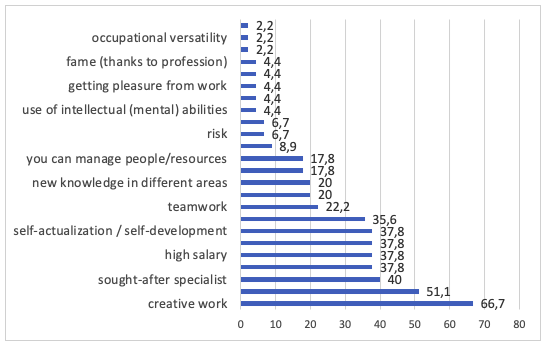
The first place is held by the answer ‘creative work’ (66.7%), half of the respondents have chosen the answer ‘communication with people/new acquaintances’ (51.1%) and slightly less than half of the students believe that they will be in demand in the modern world (40%).
None of the first-year students specified career advancement as an advantage unlike the students of other years.
The disadvantages highlighted by the first-year students are shown in Figure 2. Among the disadvantages of the future professional activity, ‘risks’ are mainly mentioned (37.8%) and ‘almost no free time’ (35.6%).
When the answer is ‘unknown profession’ (24.4%), the respondents wrote the following comment: friends, relatives often ask “what innovatics is”.
When respondents mentioned salary as a disadvantage, they meant both low and unstable salaries (depending on the implementation/non-implementation and innovation projects).
The most popular question the first-year students are interested in is that of the ability to generate ideas (31.1%) (Fig. 3).
Figure 2
Disadvantages of the innovator profession
(in % of the total number of respondents)
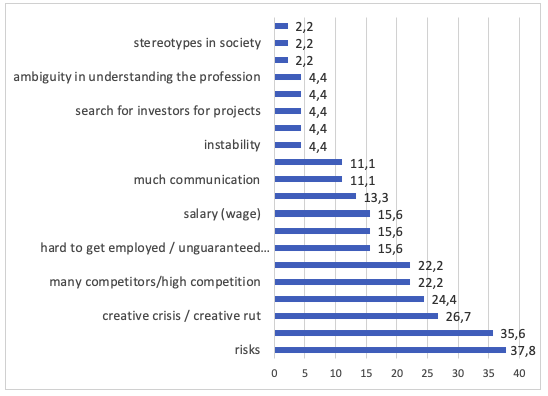
-----
Figure 3
Answers to the question ‘what is interesting in the future professional activity?’
(in % of the total number of respondents)
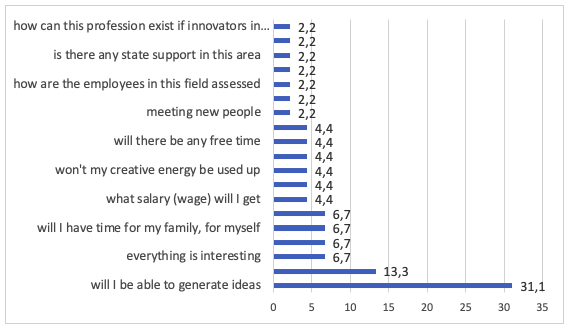
-----
The proposed table was completed by the second-year students, and the results are show in the diagrams in Figures 4 to 6.
Figure 4
Advantages of the chosen profession
(in % of the total number of respondents)
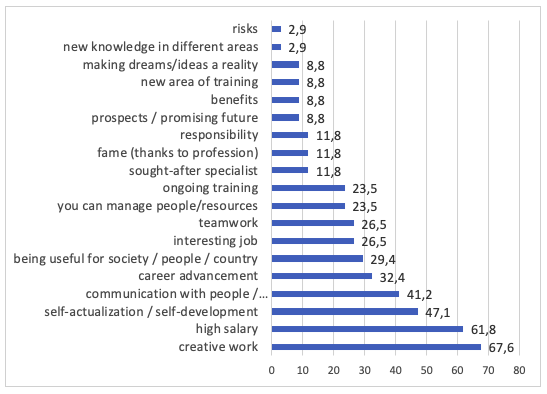
-----
Among the advantages of the chosen profession, the second-year students specify as follows: creative work (67.6%), high wages (61.8%), opportunity for self-development (47.1%) and constant communication with people (41.2%).
Among the disadvantages of the future professional activities are the disadvantages such as two much time has to be spent on work (55.9%), complexity of work (44.1%), work exposed to risks (44.1%) and awesome responsibility (41.2%).
Figure 5
Disadvantages of the chosen profession
(in % of the total number of respondents)
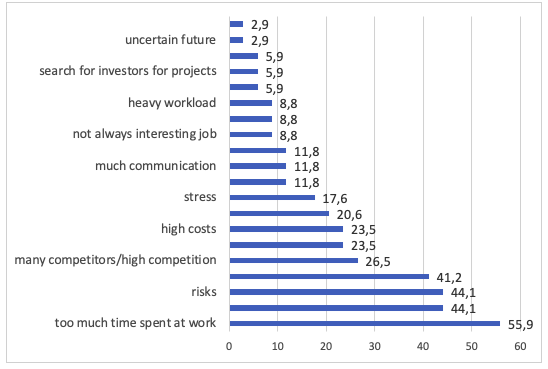
-----
Figure 6
Answers to the question ‘what is interesting in the future professional activity?’
(in % of the total number of respondents)
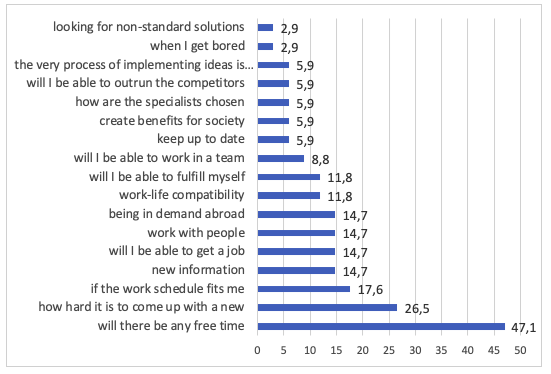
-----
And, based on the above-mentioned disadvantages, the students (47.1%) have a legitimate question: will we have free time?
The third-year students see the advantages of their choice of profession in different prospects opened up to them (75%), in the acquisition of new knowledge and versatility of the field of study (60% each) (Fig. 7).
Figure 7
Advantages of the chosen profession
(in % of the total number of respondents)
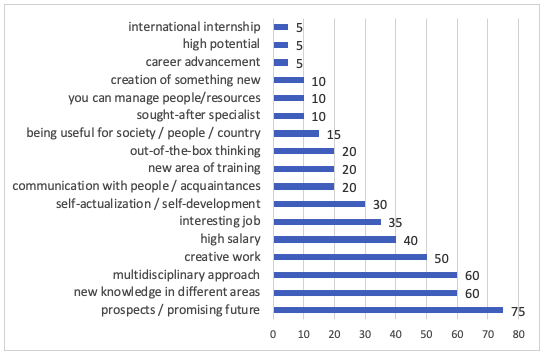
-----
Disadvantages and issues the students are interested in, related to their future professional activities are shown in Figure 8 and Figure 9.
The more senior students are the more they think about their future job in the profession chosen by them. The students undertake an internship at enterprises and organizations and face the fact that for most people their profession is unknown and incomprehensible. Therefore, the answer ‘unknown profession’ is a logical one among the disadvantages (55%).
And the main question for students is: “Will I be able to work in this area?” (Fig. 9).
Figure 8
Disadvantages of the chosen profession
(in % of the total number of respondents)
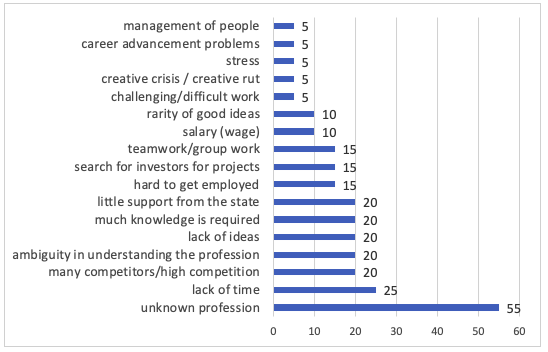
-----
Figure 9
Answers to the question ‘what is interesting in the future professional activity?’
(in % of the total number of respondents)
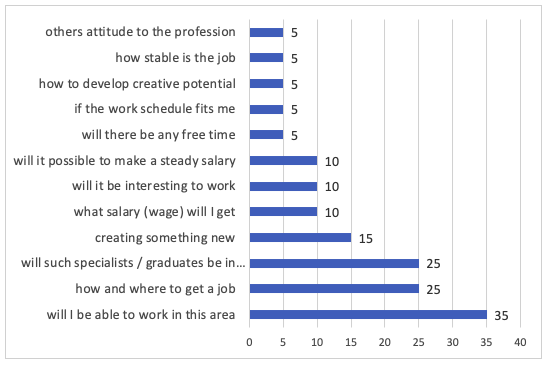
-----
The results of the survey of the fourth-year students are shown in Figures 10 to 12.
The forth-year students positively assess the availability of a wide range of areas for their future professional activities (66.7%). However, they mention the difficulty to get employed in the chosen specialty and the non-guaranteed employment (66.7%) as disadvantages. And the name of the discipline as such seems to be most interesting to them (16.7%).
Figure 10
Advantages of the future professional activity
(in % of the total number of respondents)

-----
Due to the wide range of opinions of students from different courses, the consolidated data present answers chosen by more than 10% respondents in the first two questions and by more than 5% in the last question (Figures 13 to 15).
Among the advantages of the profession the leading answer is ‘creative work’ (63.1% of respondents have chosen this answer), followed by ‘high salary’ (43.2%), and then followed by ‘communication with people’ (39.6%), ‘opportunity for self-actualization/self-development’ (37.8%) and ‘interesting job’ (32.4%).
Figure 11
Disadvantages of the future professional activity
(in % of the total number of respondents)
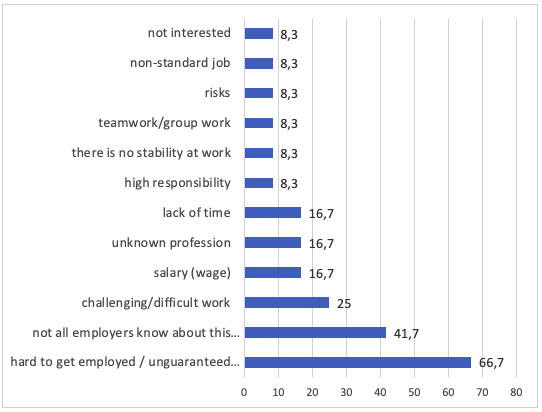
-----
Figure 12
Answers to the question ‘what is interesting in the future professional activity?’
(in % of the total number of respondents)
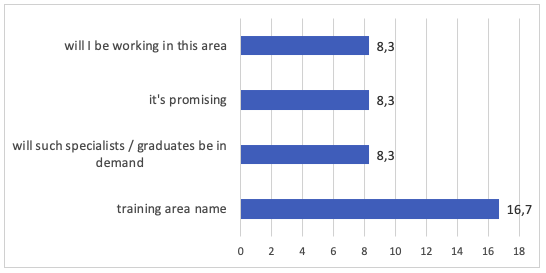
-----
Figure 13
Advantages of the innovator profession
(in % of the total number of respondents)
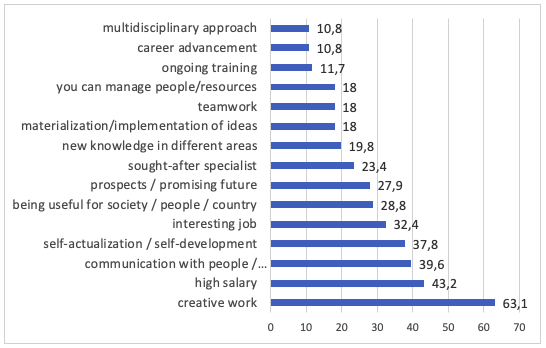
-----
Figure 14
Disadvantages of the innovator profession
(in % of the total number of respondents)
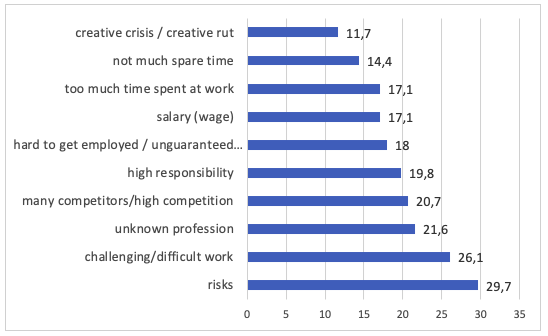
-----
Risks (29.7%) and challenging/difficult work (26.1%) were mentioned as disadvantages, including the fact that the profession is unknown to both public and employers (specified by 21.6%) while 21.6% of the respondents believe that this professional area is highly competitive.
Figure 15
Answers to the question ‘what is interesting in the future professional activity?’
(in % of the total number of respondents)
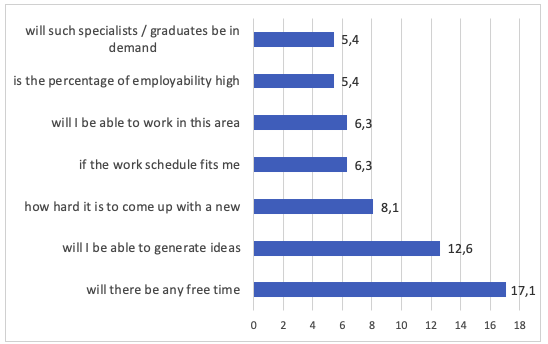
-----
There are answers that both relate to advantages and disadvantages of the profession, such as salary, teamwork, responsibility, communication with people, and difficulty of work. This indicates that different people perceive and evaluate different opportunities of the profession differently.
Thus, based on the received results, we can conclude that though the future profession is challenging and associated with various risks, as well as time-consuming for the students that study Innovatics, it is creative and rather promising in the modern world. As mentioned above, there is no univocal opinion as to who innovators are. Let us present the results of the research described in the book The Innovator's DNA: Mastering the Five Skills of Disruptive Innovators (Dyer, Gregersen, Christensen, 2018). According to the authors of this book, innovators are distinguished by five characteristics (discovery skills):
-Associating (associational thinking that helps to find new ideas);
-Questioning (skill to ask questions, original questions aimed at finding a new view, new opportunities, etc.);
-Observing (continuous observation and discovery of new ideas based thereon);
-Networking (search and testing of ideas using non-traditional methods, search for different views and different ways of looking at things);
-Experimenting (continuous testing of various, adventurous hypothesis, conducting research, testing of something new).
Considering that the modern development of the economy involves the increasing role of production of high-tech products, intellectualization of resources, reliance on innovative sources of growth, etc. (Mandych, Bykova, 2019; Nadtochiy, 2019; Bodrova, Pirumov, 2016), new requirements to the training of future employees in the area of innovation are also imposed. The most significant is the students’ (future innovators’ in particular) development of heuristic, associative thinking and creative search skills.
Bondarenko I.V. (2011). Novators and Innovators: Hurdle Race // HR-Portal website. https https://hr-portal.ru/blog/novatory-i-innovatory-beg-s-prepyatstviyami
Tsoi L. N. (2007). Organizational Conflict Management. 111 Questions, 111 Answers [Electronic resource]. http://ecsocman.hse.ru/text/35874442.html
Dyer J. (2018) The Innovator's DNA: Mastering the Five Skills of Disruptive Innovators / Jeff Dyer, Hal Gregersen, Clayton M. Christensen. Moscow: Eksmo, 320 p. (in Russ.).
Mandych I.A., Bykova A.V. (2019). Trends in innovation and investment development of high-tech enterprises // Rossiiskii tekhnologicheskii zhurnal (Russian Technological Journal). 7(5): 79-92 (in Russ.) https://rtj.mirea.ru/upload/medialibrary/b6d/RTZH_2019_5_79_92.pdf
Nadtochiy Yu.B. (2019). Spotlight on Russia higher technical education: results of student survey // International Transaction Journal of Engineering, Management, & Applied Sciences & Technologies. 10 (7): 897-902.
Bodrova E.V., Pirumov A.R. (2016). High-skilled technology and engineering professionals training as a key factor of Russian Federation successful modernization // Rossiiskii tekhnologicheskii zhurnal (Russian Technological Journal). 4 (4): 62-70 (in Russ.). https://rtj.mirea.ru/upload/medialibrary/6d1/6_bodrovawatermark.pdf
1. Associate Professor, Candidate of Pedagogical Sciences, Associate Professor at Department of Economics and Innovation Entrepreneurship, Institute of Economics and Law, MIREA – Russian Technological University (RTU MIREA), Moscow, Russian Federation. yflnjxbq-7e@yandex.ru
[Index]
revistaespacios.com

This work is under a Creative Commons Attribution-
NonCommercial 4.0 International License